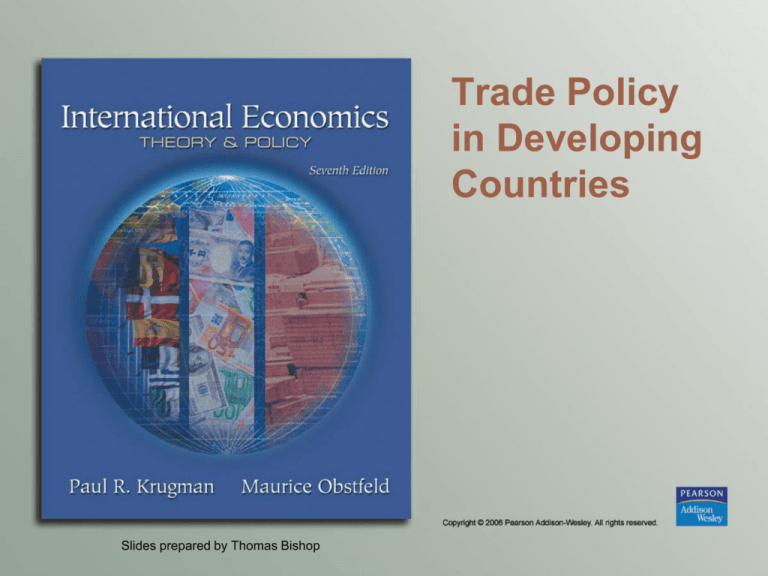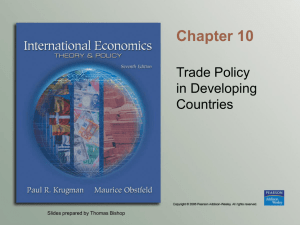
Trade Policy
in Developing
Countries
Slides prepared by Thomas Bishop
Preview
• Import substituting industrialization
• Trade liberalization since 1985
• Export oriented industrialization
.
Copyright © 2007 Pearson Addison-Wesley. All rights reserved.
10-2
14-2
Introduction
• Which countries are “developing countries”?
• The term “developing countries” does not have a
precise definition, but it is a name given to many low
and middle income countries.
10-3
Copyright © 2007 Pearson Addison-Wesley. All rights reserved.
14-3
Introduction
10-4
Copyright © 2007 Pearson Addison-Wesley. All rights reserved.
14-4
Import Substituting Industrialization
• Import substituting industrialization was a trade
policy adopted by many low and middle income
countries before the 1980s.
• The policy aimed to encourage domestic industries by
limiting competing imports.
• It was often accompanied with the belief that poor
countries would be exploited by rich countries
through international financial markets and trade.
10-5
Copyright © 2007 Pearson Addison-Wesley. All rights reserved.
14-5
Import Substituting Industrialization (cont.)
10-6
Copyright © 2007 Pearson Addison-Wesley. All rights reserved.
14-6
Import Substituting Industrialization (cont.)
• The principal justification of this policy was/is the
infant industry argument:
– Countries may have a potential comparative advantage in
some industries, but these industries can not initially
compete with well-established industries in other countries.
– To allow these industries to establish themselves,
governments should temporarily support them
until they have grown strong enough to compete
internationally.
10-7
Copyright © 2007 Pearson Addison-Wesley. All rights reserved.
14-7
Problems With the
Infant Industry Argument
1. It may be wasteful to support industries now that
will have a comparative advantage in the future.
2. With protection, infant industries may never “grow
up” or become competitive.
3. There is no justification for government
intervention unless there is a market failure that
prevents the private sector from investing in the
infant industry.
Copyright © 2006 Pearson Addison-Wesley. All
Copyright © 2007 Pearson Addison-Wesley. All rights reserved.
10-8
14-8
Infant Industry Protection
• Infant industry protection occurs when a tariff in one period
causes an increase in output, and therefore a reduction in
future costs, sufficient to allow the firm to survive, whereas
otherwise it would not.
• Old idea raised by Hamilton (1791), List (1856), and Mill
(1909).
• Crucial assumption: the firm needs to earn positive profits in
each period, and the intertemporal financing is not allowed.
• Historical example: U.S. steel rail industry (Head, 1994)
10-9
Copyright © 2007 Pearson Addison-Wesley. All rights reserved.
14-9
A Current Example
• Protection of U.S. motorcycle industry.
• The tariff rate of motorcycle imported from Japan dropped in each year
starting from 1982:
• 1983: 45%
• 1984: 35%
• 1985: 25%
• 1986: 15%
• 1987: 10%
• Feenstra (1989) found that the whole tariff increase was almost fully passed
through to the U.S. domestic price.
• In other words, the terms of trade didn’t increase due to the tariff
• Why?
10-10
Copyright © 2007 Pearson Addison-Wesley. All rights reserved.
14-10
A Current Example
• At that moment, there is already a price war in the motorcycle
market, the world price is almost close to its marginal cost.
• Hence, the exporter (Japan) doesn’t want to absorb partial
price decrease due to the tariffs.
• It looks harm the U.S. welfare, but actually it protects the
motorcycle industry in the U.S. since it is an infant industry.
10-11
Copyright © 2007 Pearson Addison-Wesley. All rights reserved.
14-11
Import Substituting Industrialization
• As a strategy to encourage manufacturing industries,
import substituting industrialization in Latin
American countries worked in the 1950s and 1960s.
10-12
Copyright © 2007 Pearson Addison-Wesley. All rights reserved.
14-12
Import Substituting Industrialization (cont.)
• But economic development, not encouraging
manufacturing per se, was the ultimate goal of the
policy.
• Did import substituting industrialization promote
economic development?
– No, countries adopting these policies grew more slowly
than rich countries and other countries not adopting them.
10-13
Copyright © 2007 Pearson Addison-Wesley. All rights reserved.
14-13
Import Substituting Industrialization (cont.)
• It appeared that the infant industry argument was not as valid
as some had initially believed.
• New industries did not become competitive despite or because
of trade restrictions.
• Import substitution industrialization involved costs and
promoted wasteful use of resources:
– They involved complex, time-consuming regulations.
– They set high tariff rates for consumers, including firms that needed to
buy imported inputs for their products.
– They promoted inefficiently small industries.
10-14
Copyright © 2007 Pearson Addison-Wesley. All rights reserved.
14-14
Trade Liberalization
• There is some evidence that low and middle income
countries which had relatively free trade had higher
average economic growth than those that followed
import substituting industrialization.
– But this claim is a matter of debate.
• Regardless, by the mid-1980s many governments had
lost faith in import substituting industrialization and
began to liberalize trade.
10-15
Copyright © 2007 Pearson Addison-Wesley. All rights reserved.
14-15
Trade Liberalization (cont.)
10-16
Copyright © 2007 Pearson Addison-Wesley. All rights reserved.
14-16
Trade Liberalization (cont.)
10-17
Copyright © 2007 Pearson Addison-Wesley. All rights reserved.
14-17
Trade Liberalization (cont.)
• As with import substituting industrialization, economic
development was the ultimate goal of trade liberalization.
• Has trade liberalization promoted development?
– The evidence is mixed.
– Growth rates in Brazil and other Latin American countries
have been slower since trade liberalization than the were
during import substituting industrialization,
10-18
Copyright © 2007 Pearson Addison-Wesley. All rights reserved.
14-18
Trade Liberalization (cont.)
– But unstable macroeconomic policies and financial crises
contributed to slower growth since the 1980s.
– Other countries like India have grown faster since
liberalizing trade in the 1980s, but it is unclear to what
degree liberalized trade contributed to growth.
– Some economists also argue that trade liberalization has
contributed to income inequality, as the Hechscher-Ohlin
model predicts.
10-19
Copyright © 2007 Pearson Addison-Wesley. All rights reserved.
14-19
Export Oriented Industrialization
• Instead of import substituting industrialization,
several countries in East Asia adopted trade policies
that promoted exports in targeted industries.
– Japan, Hong Kong, Taiwan, South Korea, Singapore,
Malaysia, Thailand, Indonesia, Philippine, and China are
countries that have experienced rapid growth in various
export sectors and rapid economic growth in general.
– These economies or a subset of them are sometimes called
“high performance Asian economies”.
– NIEs, 4 small-dragon, ASEAN-4
10-20
Copyright © 2007 Pearson Addison-Wesley. All rights reserved.
14-20
Export Oriented Industrialization (cont.)
• These high performance Asian economies have
generated a high volume of exports and imports
relative to total production.
– By this standard, these economies are “open economies”.
• But it is debatable to what degree these economies
established “free trade”.
– Although evidence suggests that these economies did have
less restricted trade than other low and middle income
countries, some trade restrictions were still in effect during
different times.
10-21
Copyright © 2007 Pearson Addison-Wesley. All rights reserved.
14-21
Export Oriented Industrialization (cont.)
10-22
Copyright © 2007 Pearson Addison-Wesley. All rights reserved.
14-22
Export Oriented Industrialization (cont.)
• It is also unclear if the high volume of exports and imports
caused rapid economic growth or was merely correlated with
rapid economic growth.
– Some economists argue that the cause of rapid economic growth was
high saving and investment rates, leading to both rapid economic
growth in general and rapid economic growth in export sectors.
– In addition, almost of the high performance Asian economies have
experienced rapid growth in education, leading to high literacy and
numeracy rates important for a productive labor force.
10-23
Copyright © 2007 Pearson Addison-Wesley. All rights reserved.
14-23
Industrial Policies in East Asia
• Some East Asian economies have implemented
industrial policies: policies intended to promote
certain industries.
– Examples of industrial policies include not only tariffs,
import restrictions, and export subsidies for importcompeting industries and export industries,
– but also policies like subsidized loans for industries and
subsidized research and development.
• But not all high performance Asian economies
implemented these policies, and the ones that did had a
wide variety of policies.
10-24
Copyright © 2007 Pearson Addison-Wesley. All rights reserved.
14-24
Industrial Policies in East Asia (cont.)
• There is little evidence that countries with industrial
policies had more rapid growth in the targeted
industries than those that did not.
• There is some evidence that industrial policies failed:
chemicals, steel, automobiles were promoted by the
South Korean government in the 1970s,
– but the polices were later abandoned because
they were too expensive and did not produce desired
growth.
10-25
Copyright © 2007 Pearson Addison-Wesley. All rights reserved.
14-25
Summary
1. Import substituting industrialization aimed to
promote economic growth by restricting imports
that competed with domestic products in low and
middle income countries.
2. The infant industry argument says that new
industries (e.g., in poor countries) need temporary
trade protection because of market failures:
–
imperfect capital markets that restrict borrowing
– problems of appropriating gains from private
investment
10-26
Copyright © 2007 Pearson Addison-Wesley. All rights reserved.
14-26
Summary (cont.)
3. Import substituting industrialization was tried in
the 1950s and 1960s but by the mid-1980s it was
abandoned for trade liberalization.
4. The precise effect of liberalized trade on national
welfare is still being debated.
–
Trade helped growth in some sectors, but saying that
trade caused higher overall economic growth has
attracted some skepticism.
–
Some argue that trade has caused increased income
inequality.
10-27
Copyright © 2007 Pearson Addison-Wesley. All rights reserved.
14-27
Summary (cont.)
5.
Several East Asian economies adopted export oriented
industrialization instead of import substituting
industrialization.
–
–
6.
High export and import volumes and relatively low trade restrictions
were characteristics of this policy.
But it is unclear to what degree this policy contributed to overall
economic growth.
Some East Asian economies used more general industrial
policies as well.
–
But it is unclear to what degree this policy contributed to
or hindered overall economic growth.
10-28
Copyright © 2007 Pearson Addison-Wesley. All rights reserved.
14-28







